The Limitations and Usefulness of Biomechanics and Motion Capture for Athletes
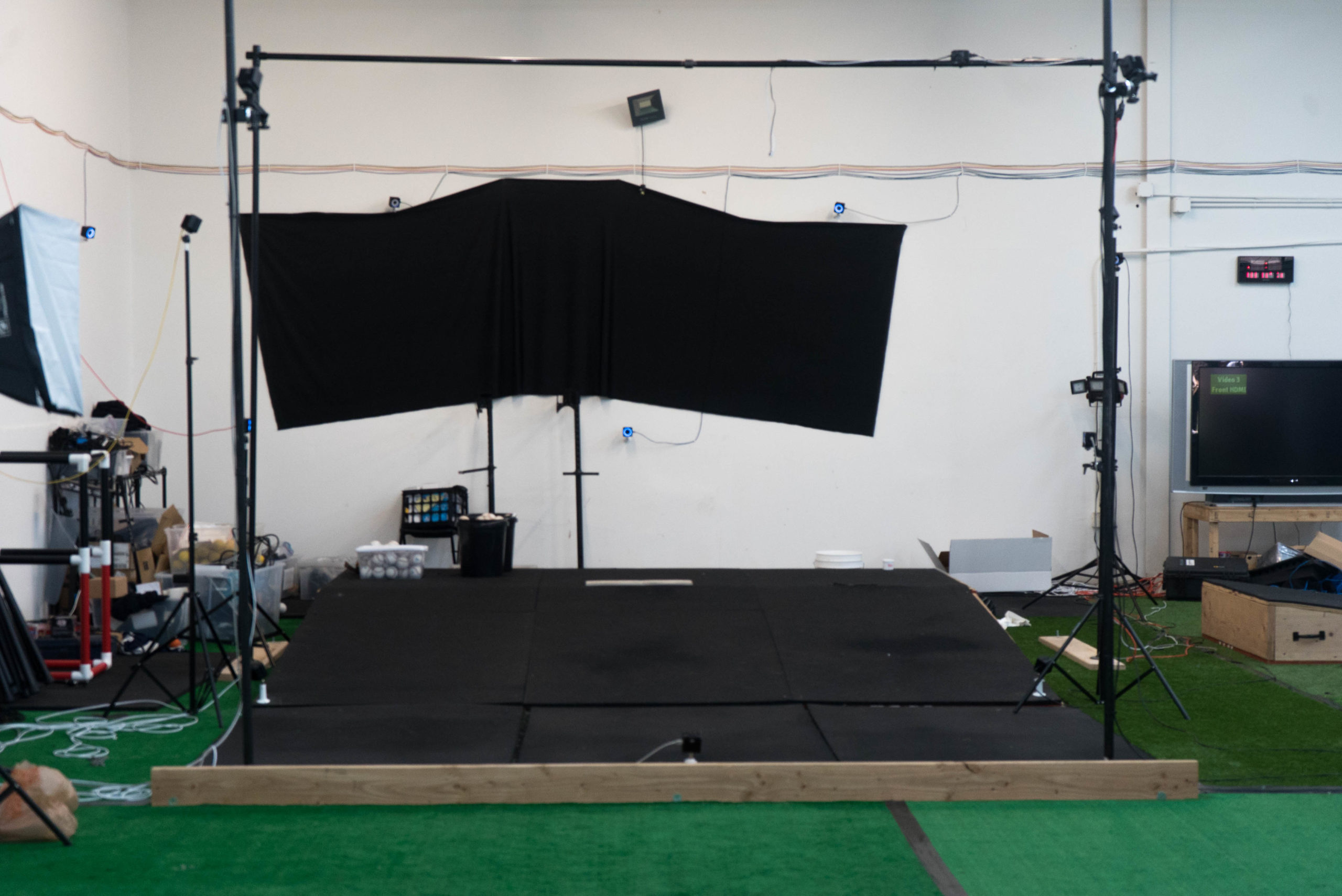
The secret to all biomechanics and motion capture boils down to a few fairly simple equations, first proposed by Abdel-Aziz and Dr. Karara. These form the basis of what is called Direct Linear Transformation (DLT).
Once you read it, you’ll know the secret to solving all the injuries that happen in baseball athletes at the elbow, basketball players at the knee, and use the power of joint torque prediction and analysis to revolutionize the game!

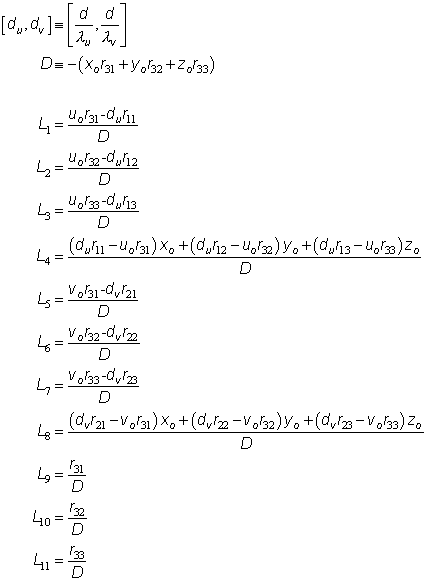
Ah, well, I guess we need to factor in calibration of the cameras, accounting for optical errors as well, so use this formula too:
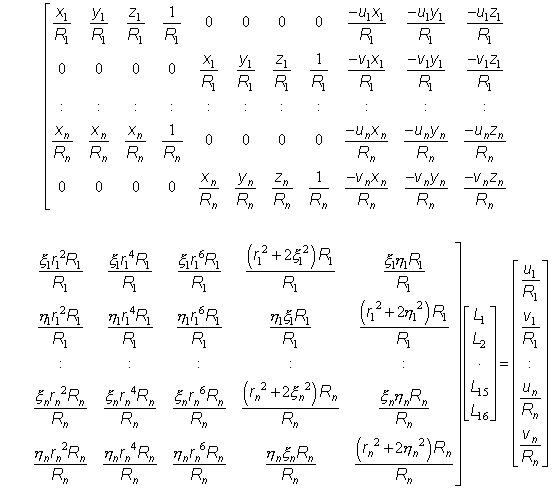
And of course, DLT reconstruction is just a few steps away:
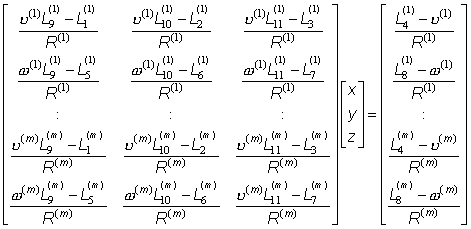 Got it? Off you go – set up some cameras, record some markers on the human body, and you too will start solving for kinematics (mechanics) and kinetics (forces/torques) soon enough! A biomechanics expert is born!
Got it? Off you go – set up some cameras, record some markers on the human body, and you too will start solving for kinematics (mechanics) and kinetics (forces/torques) soon enough! A biomechanics expert is born!
(Equation sources: kwon3d)
Alright, so it’s not that easy
Believe it or not, the above equations are how I got started in analyzing biomechanics. Off-the-shelf systems were too expensive to purchase at the time, running in the low six figures to even get started, but high-speed cameras like the Casio Exilim EX-FH2 were hitting the market at ~$500. Rather than just use the cameras for qualitative purposes and coaching cues, I wanted to know if I could create a markerless biomechanics lab using the cameras, mathematics, and some hard work. I figured if I could do this and build a biomechanics lab for baseball, that I would be on my way to solving pitching injuries and that I’d command a ton of contract work from Major League Baseball!
So, two things happened: Yes, it’s just math, and Matthew Wagshol (current biomechanist at Driveline Baseball) and I proved that we could do it, by building the control objects in the aisles of Home Depot and spending countless hours using terrible software meant for graduate students that we twisted in so many directions to just spit out answers.
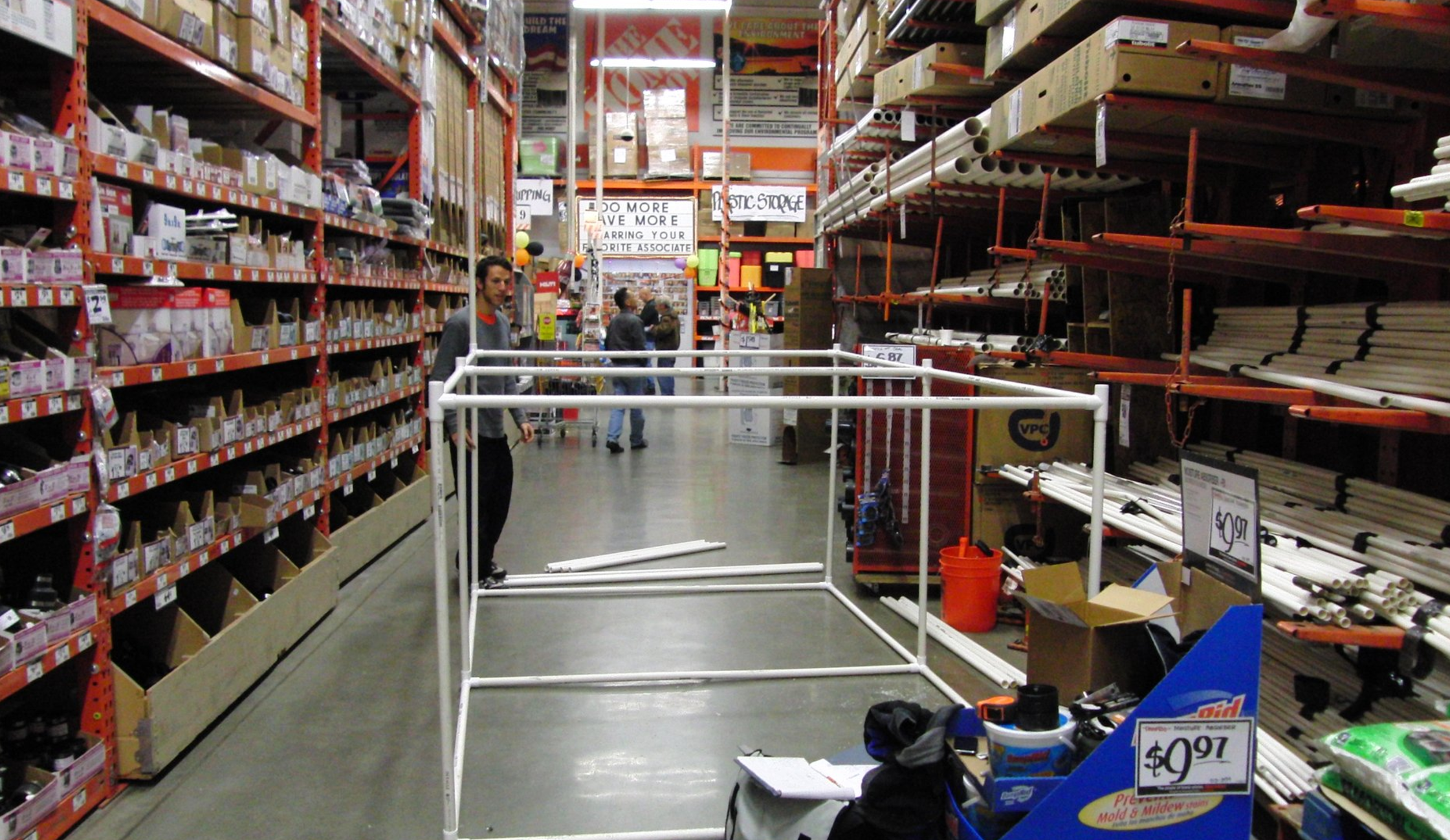
The other thing is that no one cared. No one cared that we could calculate angular velocities and joint torques using the methods pioneered by Dr. Jesus Dapena and Michael Feltner in their breakthrough paper Dynamics of the Shoulder and Elbow Joints of the Throwing Arm during a Baseball Pitch (1986) that leaned on the amazing description of DLT’s methods in Direct Linear Transformation from Comparator Coordinates into Object Space Coordinates in Close-Range Photogrammetry (1971).
I also slowly realized… that I didn’t care, either. Sure, the achievement was really cool, and as far as I could tell, no one had done it before me… but biomechanics data alone wasn’t getting my athletes major results.
Why?
Biomechanical Data is Useless…. By Itself
It turned out that all this kinematic and kinetic data we were generating after months and months of hard work were just that – piles of data. Biomechanical data does not predict or project injuries, it does not tell you who will get hurt and who will not, and it cannot tell you who has a future in the game and who should learn to develop software instead.
What I slowly began to realize – and how we use biomechanical data at Driveline Baseball now – is that this data is part of a larger thumbprint, an increasingly vital part of an athlete’s assessment. Today, we use this data for amazing purposes, and every day that goes by that we put assessments into our machine learning-enabled backend software, we learn more and more about injuries, performance, and the human body simply by doing our jobs.
Now that’s a story. But before we delve too deep into the actionable part of the data – which we talk about all the time on our blog and on social media – let’s talk about pitfalls of biomechanical analyses and the misuse of science that I see on a regular basis.
Markerless vs. Marker-Based Biomechanics Data
The methods I described above illustrate markerless biomechanics data – this means using multiple cameras to take synchronized footage of an athletic movement and to reconstruct it using DLT to get angular velocities of limbs/body parts and forces at the various joints. However, there are serious limitations with markerless data, and areas where markerless capture cannot adequately address. Here are just a few:
- Rotation about an axis – markerless capture cannot track pronation/supination
- Valgus carrying angle and other deformations can cause faulty readings due to assumptions in markerless methods
- Global vs. rolling shutter – if the cameras are rolling shutter (which most are), then the image is exposed top-down, meaning the top of the image is not at the same time as the bottom of the image
Rotation about an axis is an easy one to understand. First, a graph – this is a comparison of pronation/supination at the elbow using a marker-based system vs. a markerless one.
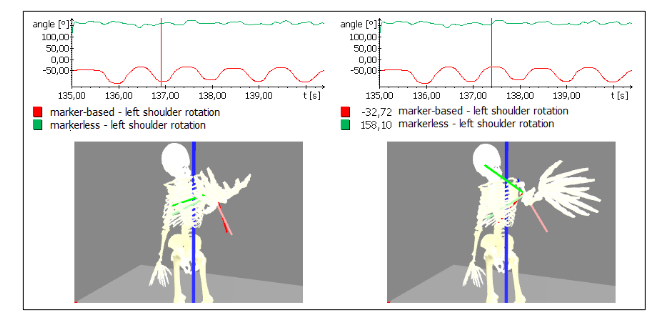
Second, a statement from a biomechanist who works in an academic lab:
You got me thinking again about the issues/problems with accuracy in measuring internal shoulder rotation… with markerless/digitizing, it comes down to carrying angle of the elbow screwing up the cross-product of upper and forearm (which is how shoulder IR/ER has to be tracked if going markerless).
Even if you simply project the forearm’s long axis onto a plane perpendicular to upper arm’s long axis, the carrying angle screws that up too. The issues begin somewhere near 25-30 degrees flexion and continue up to full extension – basically the period in which the IR is maxing out. Problem is, many simply report a number without trying to ascribe some of it to mathematical artifact.
Gordon/Dapena (2012) proved this at length in A method to determine the orientation of the upper arm about its longitudinal axis during dynamic motions.
As you can see from the image above and what the biomechanist said, markerless motion capture cannot capture pronation/supination. And from all we know about how important forearm rotation is in the pitching delivery, if we cannot capture this, that raises huge concerns.
Yet this doesn’t stop organizations and coaches using cameras and non-validated markerless methods to compute biomechanics, or worse, nonsense like drawing lines and angles on still images and calling it biometrics, biomechanics, or other buzzwords they lift from research papers they do not understand.
Science is something to be respected – and as usual, if it sounds too good to be true, it almost always is.
Using Biomechanics Data Properly to Improve Performance
So, how can we use biomechanics data to improve performance and maybe reduce the chance of injury? By taking frequent snapshots and examining how training impacts the athlete.
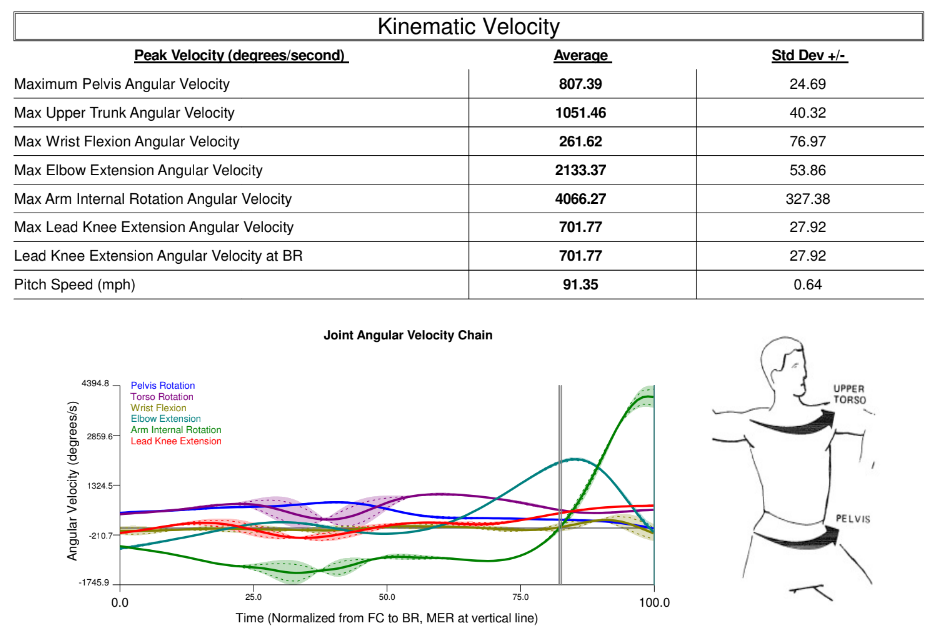
By taking thumbprints of our athletes using EMG sensors, biomechanical data, velocity data, and other metrics in our performance software database, we can expose it to machine learning methods to constantly analyze the markers that contribute most to performance gains and what seems to cause backslides in ability or worse, injury.
For example, a common issue that we have found that is a marker for injury is high angular velocity at the elbow and shoulder combined with low ball velocity. This is an efficiency problem; why does the athlete have such high arm speed, but comparatively low fastball velocity? Three things are true about this athlete:
- They are at higher risk for injury due to some breakdown in the kinetic chain
- Ball velocity would be a poor way to monitor this athlete’s throwing load
- This athlete has high potential to gain fastball velocity due to arm speed
A minor league pitcher fit these definitions a few years ago after coming to us during rehab from bone chips in his elbow. After exposing him to a minimal PlyoCare® throwing program to smooth out some mechanical deficiencies and to just give him a lower-volume throwing program to replace some days of his long toss program, his velocity went from 87-90 MPH to 92-95 MPH touching 96-97 MPH! He carved up AAA and was in the big leagues shortly thereafter, where he remains as his velocity has settled more into the low-90s as a starting pitcher.
Comparatively, there are athletes with low arm speed that we see in our biomechanical reports. These athletes can probably tolerate higher workloads to develop velocity, due to lower stresses at the elbow and shoulder.
However, the golden goose still remains being able to capture validated biomechanical data without invasive procedures like applying markers to a shirtless athlete. So, how do we get there?
Markerless Systems Moving Forward
Using marker-based systems, we can get sub-millimeter accuracy of movement. Yes, that’s right – our typical mean error in reconstruction is about 0.8mm. Marker-based biomechanics systems are incredibly precise AND accurate, while markerless systems typically lack the validation required to even make firm conclusions about precision.
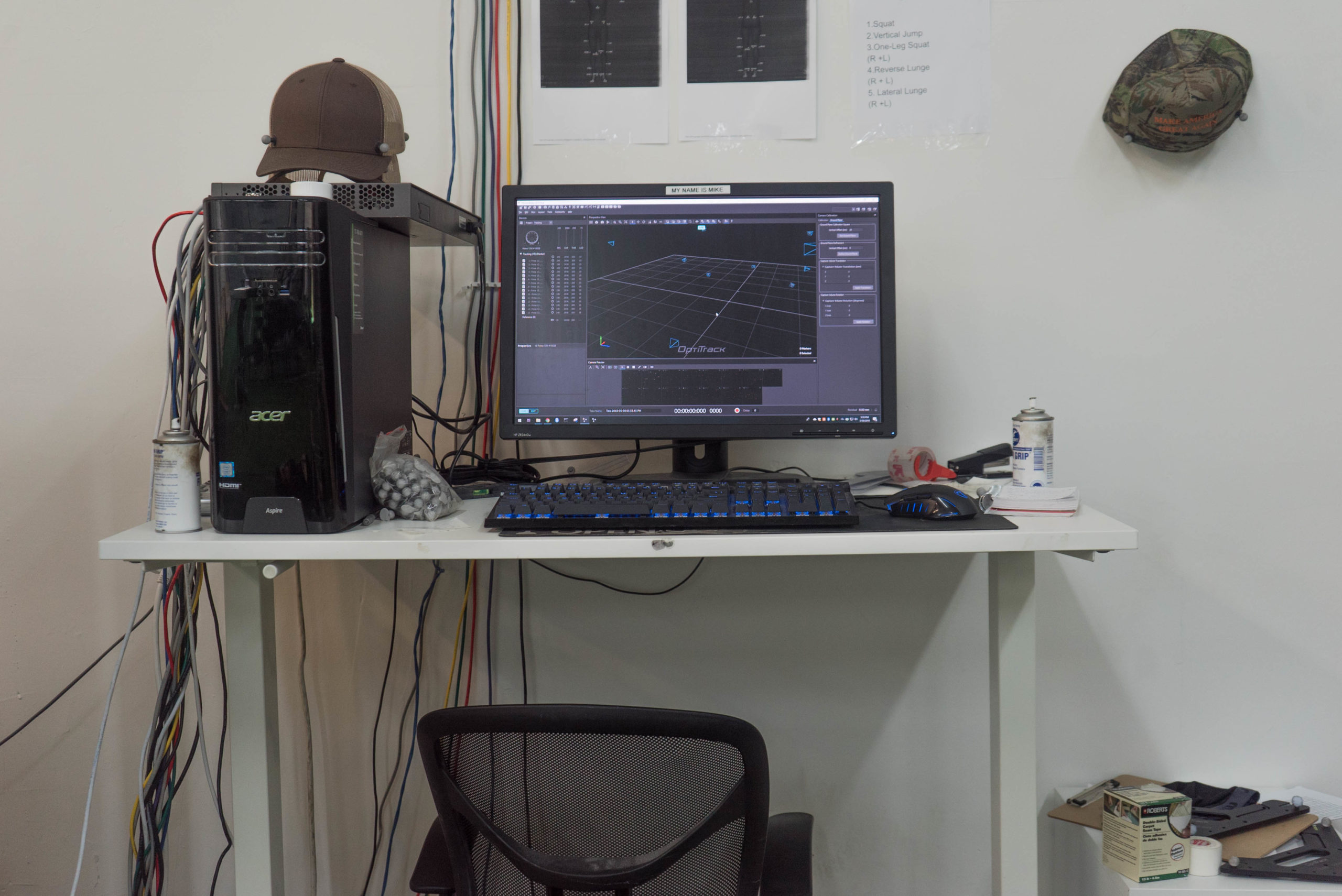
At Driveline Baseball, we are pushing markerless technology forward by planning hundreds of test cases of marker-based situations vs. markerless ones and running cross-validation tests to see just how useful markerless data can be. It’s possible that a rigid body approach using markerless data in-game could work, but no one has done the research on it or released anything that would indicate the science behind it is sound. While many organizations sell it, no one has proven it in a peer-reviewed journal or a wide release open access paper – and without that, there can be no sound conclusions made on the topic.
Remember, anyone can calculate biomechanics from markerless data – I managed to do it as a college dropout with an intern in the aisles of Home Depot and in a facility located inside of a trailer park. But as many biomechanists and scientists reminded me, it’s not about spitting out data – it’s about going the extra mile and validating your work; proving that you know what you’re talking about. As a physicist at Cal Berkeley once said:
[bctt tweet=”Being rigorous is like being pregnant: You can’t be a little bit pregnant”]
For decades, organizations that have been funded by MLB have churned out thousands of biomechanics reports, and their abilities to predict injury or performance gain have been minimal at best. What the decades of research do show us, however, are how to refine analyses and data collection. Science is a collaborative and iterative process, and we truly stand on the shoulders of giants like Dr. Jesus Dapena, Michael Feltner, Abdel-Aziz, Dr. James Andrews, Dr. Glenn Fleisig, and Dr. Karara.
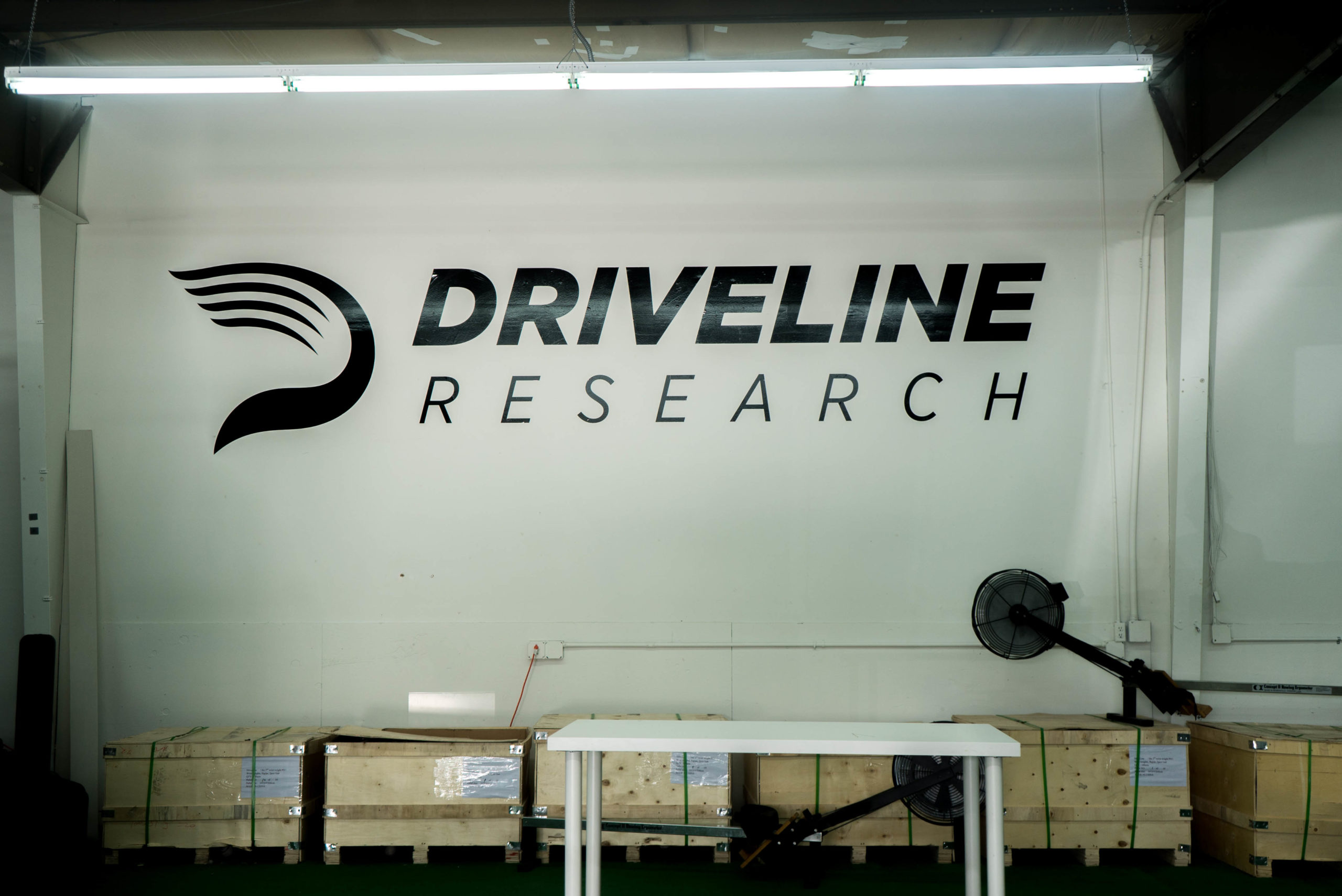
Driveline Research looks forward to moving the ball down the field of biomechanics, and doing so openly.
(This post was written by Kyle Boddy, Founder of Driveline Baseball and Director of Research and Development)
Comment section
Add a Comment
You must be logged in to post a comment.
Applied Sports Science newsletter – June 4, 2018 | Sports.BradStenger.com -
[…] The Limitations and Usefulness of Biomechanics and Motion Capture for Athletes […]